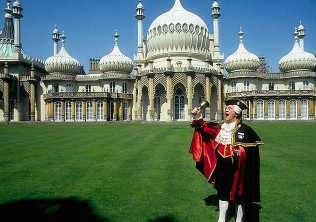
 Brighton and Hove
Brighton and Hove

Brighton and Hove is the most enchanting, exciting, extraordinary seaside city in Britain.
With its cosmopolitan air, oodles of restaurants, feverish nightlife and abundance of culture, the place defies comparison with anywhere else this side of the English Channel.
The Heritage of Brighton
 Wandering around 'The Lanes' (a maze of narrow streets and alleyways just off the seafront) you can easily imagine the small fishing community of Brighthelmstone, with shadowy figures ducking down the narrow 'twittens' and sheltering from the strong winds, possibly engaged in a little smuggling
Wandering around 'The Lanes' (a maze of narrow streets and alleyways just off the seafront) you can easily imagine the small fishing community of Brighthelmstone, with shadowy figures ducking down the narrow 'twittens' and sheltering from the strong winds, possibly engaged in a little smuggling
Turn the corner and you will find elegant, graceful buildings redolent of the silk and ruffles of the Regency dandy.
Brighton began as a small fishing village constantly at the mercy of French raiders and the sea. After a great storm in 1724 many of the houses were washed away and the townspeople were granted a "Brief', to beg for money all over England to raise banks against the sea.
The town's transformation from a small fishing and farming village began when it was 'discovered' in 1750 by Dr Richard Russell who proclaimed the therapeutic benefits of his amazing sea-water cure. Almost overnight it became the fashionable watering hole of London High Society.
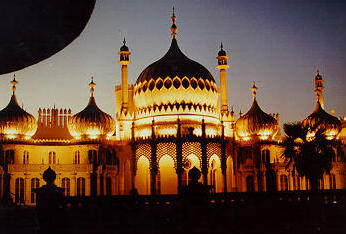 When George, Prince of Wales - later to become Prince Regent and then George IV - decided to make his home here, Brighton's popularity soared.
When George, Prince of Wales - later to become Prince Regent and then George IV - decided to make his home here, Brighton's popularity soared.
The town underwent an amazing transformation. Local people made money by providing bathing machines which carried the bathers into the sea and bathing attendants known as 'dippers' stood by - ready to duck reluctant bathers. One of the most famous of these, Martha Gunn, is buried in St Nicholas churchyard.
Although well-known for its connection with the Prince Regent, the first recorded Royal visitor was Charles II. After his escape from the Battle of Worcester in 1651, he hid from the Roundheads disguised as a servant. He stayed in the George Inn in West Street (later renamed the Kings Head) and escaped to France by boat, now celebrated every May with a race from Brighton to France, appropriately named the Royal Escape.
A PRINCE'S PALACE
The Prince of Wales liked Brighton so much that he decided to move here. At first his cook rented a small farmhouse for him, which he eventually bought and improved. Over a period of years it grew from a modest classical building to the magnificent oriental palace we see today. The Prince had flamboyant tastes and scant regard for economy and budgeting. The first changes were made in 1787 when Henry Holland was engaged to enlarge and refurbish the humble farmhouse.
With the addition of a domed rotunda and a new wing it became known as the 'Marine Pavilion'. Further alterations were made in 1801 with the addition of a new entrance, conservatory etc.....At the same time Frederick Crace introduced the Chinese theme into the interior.
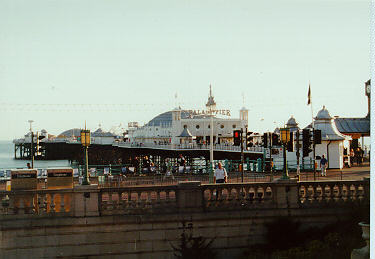 Meanwhile, William Porden was designing new stables for the Prince's horses. Inspired by water colour pictures of India he created an incredible building in the Indo-Saracenic style with a vast dome (24 metres in diameter and 19 metres high) covering the main hall. Many pessimists predicted that this daring construction would collapse once the scaffolding was removed!
Meanwhile, William Porden was designing new stables for the Prince's horses. Inspired by water colour pictures of India he created an incredible building in the Indo-Saracenic style with a vast dome (24 metres in diameter and 19 metres high) covering the main hall. Many pessimists predicted that this daring construction would collapse once the scaffolding was removed!
Now known as The Dome it has been converted into a modern concert hall, while the western riding hall has become an exhibition hall known as The Corn Exchange.
Once completed, these buildings were so impressive that they completely upstaged the Royal Pavilion itself. So, it was back to the drawing board, and the Prince ordered another round of improvements. The project was taken over by John Nash in 1813, and it was at this stage that the Pavilion took on its present ornate form.
Nash built over and around Holland's original structure, introducing a huge central dome over the Saloon and tent-like roofs over the Banqueting Hall and Music Room.
The Prince of Wales was far from conventional and is known to have kept a number of mistresses. But he fell deeply in love with Mrs Maria Fitzherbert. By English law the Prince was not allowed to marry without the King's consent, and as Maria Fitzherbert was a Catholic, the Prince knew his father would never approve. They therefore married secretly in 1785. Mrs Fitzherbert did not live at the Pavilion but a house was built for her nearby. This can still be seen, although much altered, and is now the YMCA in Old Steine.
There are reputed to have been secret passageways from this house to the Royal Pavilion but alas their exact whereabouts are no longer known, if indeed they existed.
The relationship flourished for a number of years. Eventually, as his debts mounted King George III forced the Prince to divorce Maria Fitzherbert and marry Caroline of Brunswick. Caroline was a Protestant Princess and could therefore become Queen.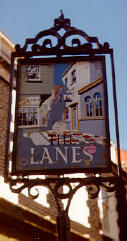 However, they detested each other and the marriage was a disaster. George would not live with Caroline and refused to let her into Westminster Abbey for the Coronation when he became King. They had only one daughter who died in childbirth. He later returned to Mrs Fitzherbert and when he died in 1830 her miniature was found around his neck. Maria Fitzherbert died in 1837 and is buried in the chapel of St John the Baptist in St Georges Road.
However, they detested each other and the marriage was a disaster. George would not live with Caroline and refused to let her into Westminster Abbey for the Coronation when he became King. They had only one daughter who died in childbirth. He later returned to Mrs Fitzherbert and when he died in 1830 her miniature was found around his neck. Maria Fitzherbert died in 1837 and is buried in the chapel of St John the Baptist in St Georges Road.
There's nothing quite like a bracing walk along the prom or a stroll out to sea on the Palace Pier to clear heads and revive appetites!
On a wild and wintry day it's an exhilarating experience. If you'd rather ride, take the Volk's Electric Railway, England's oldest, along Madeira Drive to the Brighton Marina, admiring the fine Regency terraces as you go.
Experience all the thrills of traditional and modern rides on the pier - there's a wonderful atmosphere at dusk when the sun goes down and the lights come on.
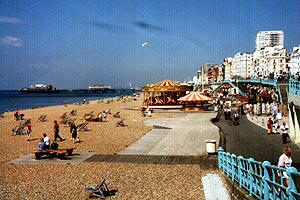 Strolling along from the Palace Pier towards Hove, you'll find the Artists' Quarter where you can buy individual, one-off pieces from prints and paintings to driftwood mirrors and wrought iron beds - perfect for special gifts.
Strolling along from the Palace Pier towards Hove, you'll find the Artists' Quarter where you can buy individual, one-off pieces from prints and paintings to driftwood mirrors and wrought iron beds - perfect for special gifts.
Further along is the Fishing Museum, with a full size Sussex fishing boat and rare archive film of bathers at the turn of the century. There are stylish cafes, bars and restaurants where you can relax and enjoy the view.
There are all kinds of watersports to try and you can hire in-line skates to rollerblade along the esplanade, or play petanque (like boules) on the piste next to Alfresco's. And Hove's wide, elegant esplanade and peaceful lawns are perfect for strolling, picnicking, kite-flying and playing.
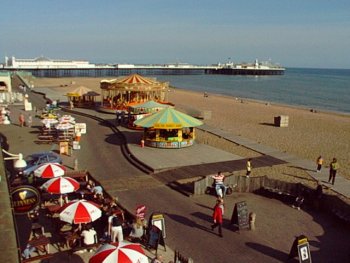 So whether you're looking for recreation, razzle dazzle or rest and relaxation, the seafront is the place to be.
So whether you're looking for recreation, razzle dazzle or rest and relaxation, the seafront is the place to be.
In the 1830's, a steam railway was built from London to Brighton and during the next 50 years it gave the well-to-do, middle classes of the capital an opportunity to travel down to the coast. A "day at the seaside" became a Victorian institution which, with a walk along the seafront - "on the promenade", taking tea and listening to music in the open air (played by a military band) gave a much needed week-end break as the city of London became increasingly polluted by domestic noise and smoke.
The pier, widely regarded as the finest example of this peculiarly British form of architecture, was built In 1866. It stretched far out to sea, initially serving the practical purpose of allowing the Dieppe steam packet to dock at low tide. It was soon developed, however, to provide further opportunities for "taking the sea air" and for the gently relaxing 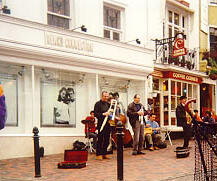 entertainments offered by pierrot shows, jugglers and fortune tellers.
entertainments offered by pierrot shows, jugglers and fortune tellers.
With the introduction of holidays with pay in 1911 the resorts on the South Coast became extremely popular with London holidaymakers looking to spend a week or more at the seaside. During this time many boarding houses were built and the legend of the seaside landlady entered English folklore. Brighton, however, remained the favourite of the middle classes and became, as the train service improved, an increasingly popular place for the better off Londoners to live.
Today, Brighton and the neighbouring town of Hove have a population of 230,000 people but it retains much of the charm of its Georgian heritage. The famous "Lanes" contain antique and jewellery shops and the restaurants and busy pubs are grouped together in a close criss-cross of byways that reflect the original layout of the seventeenth century fishing village.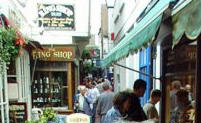 For browsers and bargain hunters interested in antique furniture and collectors of books, clocks and china it is one of the most fascinating towns in England. It is well served with tea gardens and open-air caf�s. and although the original pier was recently damaged by fire the the Victorian Palace Pier with its fun fair and fortune tellers has superbly restored and the town remains very popular with younger London visitors.
For browsers and bargain hunters interested in antique furniture and collectors of books, clocks and china it is one of the most fascinating towns in England. It is well served with tea gardens and open-air caf�s. and although the original pier was recently damaged by fire the the Victorian Palace Pier with its fun fair and fortune tellers has superbly restored and the town remains very popular with younger London visitors.
The Dome auditorium and the Royal Theatre cater for those looking for discos and lively evening entertainment while the bohemian North Lane area offers fashionable clothes and crafts.  For the very young there are the traditional treats of Brighton Rock, a ruinous stick of sticky candy, and kites to catch the offshore early evening breeze.
For the very young there are the traditional treats of Brighton Rock, a ruinous stick of sticky candy, and kites to catch the offshore early evening breeze.
For over 400 years The Lanes in Brighton have twisted and turned from the seafront to North Street in a network of cobbled courtyards and narrow twittens.
Take time to explore the squares and streets steeped in history, where every building has a tale to tell and there�s a wealth of architectural detail to delight the eye. The Georgian Elim Chapel, dating from the reign of Charles II, is now a popular pub, while the Assembly Rooms at the seafront end of Ship Street once rang to the declamations of Dr. Samuel Johnson and Charles Dickens.
The North Laine has an atmosphere entirely its own. Crammed with character, brimming with caf�s, rich in restaurants, pubs, bars and bric-�-brac, and an astonishing range of specialist shops.
Threading your way through the North Laine takes you to over 350 of the most individual shops you�ll ever see, displaying goods of every description from all over the world. Here are clothes, carpets and candles; bangles, beads, batiks and baskets; furnishings, food and cookware; masks and musical instruments - from Africa, India, Malaysia, South America and beyond.
Here too you�ll find the designer names of the future, with fab fashion from bargain chic to sophisticated style, plus saris to swoon over. You can be serenaded at market stalls, choose from locally made arts and crafts, or take the weight off your feet and watch the world go by from cosy caf�s.
Whatever you decide to do, exploring the North Laine is tremendous fun and a great way of starting to discover the sheer diversity of Brighton.
Castles and towns worth visiting within half day's excursion of Brighton.
Arundel Castle, situated in magnificent grounds overlooking the river Arun was built in the 11th century by Roger de Montgomery, Earl of Arundel. During the civil war in 1643 it was badly damaged by fire but was restored in the 18th century by the 8th and 11th Dukes of Norfolk. Personal possessions of Mary, Queen of Scots and a selection of historical and religious items are housed in its museums and there are fine collections of old masters and 16th century tapestries.
Arundel lies 4 miles north of Littlehampton, there are frequent trains from Brighton and the Castle is ten minutes walk from the station.
Hever Castle, was the home of Anne Boleyn, Henry VIII's second wife and mother of Elizabeth 1. It is a moated castle with a beautiful interior surrounded by extensive, established gardens which include a lake, an Italian garden, statuary and topiary.
Leeds Castle near Maidstone was converted from a fairytale medieval castle into a Royal Palace by Henry VIII. Set in magnificent parkland it contains a fine collection of paintings and tapestries.
 Bodiam Castle is the finest example of a medieval moated castle in Britain. Close by is the ancient cinque port town of Rye built on the edge of the Romney Marshes. Within easy drive of Rye is Battle Abbey which is built on the site at which William the Conqueror won the Battle of Hastings in 1066.
Bodiam Castle is the finest example of a medieval moated castle in Britain. Close by is the ancient cinque port town of Rye built on the edge of the Romney Marshes. Within easy drive of Rye is Battle Abbey which is built on the site at which William the Conqueror won the Battle of Hastings in 1066.
.
 Return to the Fridge door
Return to the Fridge door